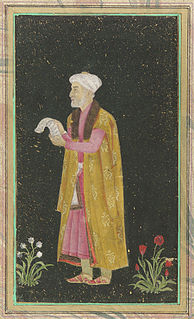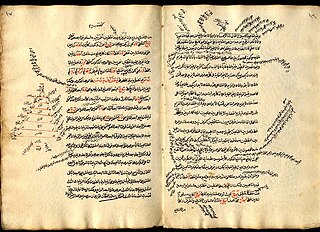 W
WHis name is given as Jamāl-al-Din Moḥammad Sidi in the early sources. He lived from 963 AH-999 AH; c. 1556-1590 CE; known by his pen-name Urfi, or Orfi or Urfi Shirazi, was a 16th-century Persian poet.
 W
WAbbas the Great or Abbas I of Persia was the 5th Safavid Shah (king) of Iran, and is generally considered as one of the greatest rulers of Persian history and the Safavid dynasty. He was the third son of Shah Mohammad Khodabanda.
 W
WReza Abbasi, Riza yi-Abbasi or Reza-e Abbasi, رضا عباسی in Persian, usually Reza Abbasi also Aqa Reza or Āqā Riżā Kāshānī was the leading Persian miniaturist of the Isfahan School during the later Safavid period, spending most of his career working for Shah Abbas I. He is considered to be the last great master of the Persian miniature, best known for his single miniatures for muraqqa or albums, especially single figures of beautiful youths.
 W
WAbu'l-Hasan entitled by the Mughal emperor Jahangir as Asaf Khan, was the Grand Vizier of the fifth Mughal emperor Shah Jahan. He previously served as the vakil of Jahangir. Asaf Khan is perhaps best known for being the father of Arjumand Banu Begum, the chief consort of Shah Jahan and the older brother of Empress Nur Jahan, the chief consort of Jahangir.
 W
WSultan Ali Mashhadi (1453-1520) was a Persian calligrapher and poet.
 W
WAbu'l Ghazi Sultan Alqas Mirza, better known as Alqas Mirza (15 March 1516 – 9 April 1550), was a Safavid prince and the second son of king (shah) Ismail I. In early 1546, with Ottoman help, he staged a revolt against his brother Tahmasp I, who was king at the time.
 W
WBaba Shah Isfahani, also known as Baba Shah Araghi, was the most famous Iranian calligrapher in the 16th century and the most prominent calligrapher of Nastaliq script in the era of Tahmasp I. He was titled as Reyis or-Roassa. His calligraphy teacher was Ahmad Mashhadi. In 1588, when he was young, he ravelled to Iraq. He was killed in Baghdad and was buried in this city. His works date back from 1569 until 1586.
 W
WBahāʾ al‐Dīn Muḥammad ibn Ḥusayn al‐ʿĀmilī was an Arab Iranian Shia Islamic scholar, philosopher, architect, mathematician, astronomer and poet who lived in the late 16th and early 17th centuries in Safavid Iran. He was born in Baalbek, Ottoman Syria but immigrated in his childhood to Safavid Iran with the rest of his family. He was one of the earliest astronomers in the Islamic world to suggest the possibility of the Earth's movement prior to the spread of the Copernican theory. He is considered one of the main co-founders of Isfahan School of Islamic Philosophy. In later years he became one of the teachers of Mulla Sadra.
 W
WFarrukh Beg was a Persian born Mughal painter who served in the court of Mirza Muhammad Hakim before working directly for Mughal Emperor Akbar. He was trained in the Persian miniature style and remained relatively close to it all his life. He was greatly admired by the Mughal emperor, Jahangir, and worked in four royal courts altogether.
 W
WHamida Banu Begum was a wife of the second Mughal emperor Humayun and the mother of his successor, the third Mughal emperor Akbar. She is also known by the title Maryam Makani, which was given to her by her son, Akbar.
 W
WKamāl ud-Dīn Behzād, also known as Kamal al-din Bihzad or Kamaleddin Behzad, was a Persian painter and head of the royal ateliers in Herat and Tabriz during the late Timurid and early Safavid Persian periods. He was very prominent in his role as a director of a workshop in the Herat Academy as well as his position in the Royal Library in the city of Herat. His art is unique in that it includes the common geometric attributes of Persian painting, while also inserting his own style, such as vast empty spaces to which the subject of the painting dances around. His art includes masterful use of value and individuality of character, with one of his most famous pieces being "The Seduction of Yusuf”' from Sa'di's Bustan of 1488. Behzād’s fame and renown in his lifetime inspired many during, and after, his life to copy his style and works due to the wide praise they received. Due to the great number of copies and difficulty with tracing origin of works, there is a large amount of contemporary work into proper attribution.
 W
WAbd Ali ibn Muhammad ibn Husayn Birjandi was a prominent 16th-century Persian astronomer, mathematician and physicist who lived in Birjand.
 W
WFarrukh Yassar was the last independent Shirvanshah of Shirvan (1465–1500). In 1500, the first Safavid ruler, Ismail I, decisively defeated and killed Farrukh Yassar during his conquest of the area. Descendants of Farrukh Yassar continued to rule Shirvan under Safavid suzerainty, until 1538, when Ismail's son and successor Tahmasp I appointed its first Safavid governor, and made it a fully functioning Safavid province.
 W
WMir Fendereski or Mir Findiriski (1562–1640) was a Persian philosopher, poet and mystic of the Safavid era. His full name is given as Sayyed Mir Abulqasim Astarabadi, and he is famously known as Fendereski. He lived for a while in Isfahan at the same time as Mir Damad spent a great part of his life in India among yogis and Zoroastrians, and learnt certain things from them. He was patronized by both the Safavid and Mughal courts. The famous Persian philosopher Mulla Sadra also studied under him.
 W
WGanj Ali Khan was a military officer in Safavid Iran of Kurdish origin, who served as governor in various provinces and was known for his loyal service to king (shah) Abbas I. Ganj Ali Khan continuously aided the shah on almost all of his military campaigns until his own death in 1624/5. He was also a great builder, the Ganjali Khan Complex being one of his finest achievements.
 W
WMirza Ghiyas Beg, also known by his title of I'timad-ud-Daulah, was an important Persian official in the Mughal empire, whose children served as wives, mothers, and generals of the Mughal emperors.
 W
WMir Emad is perhaps the most celebrated Persian calligrapher. He was born in Qazvin, Iran. It is believed that the Nastaʿlīq style reached its highest elegance in Mir Emad's works. These are amongst the finest specimens of Nastaʿlīq calligraphy and are kept in several museums in the world.
 W
WHatefi, 'Abd-Allah was a Persian poet (1454–1521) and nephew of Abdul Rahman Jami.
 W
WHossein Ali Beg Bayat was a Safavid diplomat from the Turkoman Bayat clan, who served as the ambassador to the Holy Roman Empire, the Russian Tsardom, Habsburg Spain and several other royal and noble courts during the reign of king Abbas I, and was part of the first Safavid embassy to Europe.
 W
WKamāl al-Dīn Ḥusayn ibn ʿAlī Kashifi, best simply known as Husayn Kashifi, was a prolific Persian prose-stylist, a poet, a Quran exegete, a Sufi scholar, and an astronomer of the Timurid era. Kashifi was his pen name, Wa'ez denoted his professional occupation as a preacher.
 W
WPrince Ibrahim Mirza, Solṭān Ebrāhīm Mīrzā, in full Abu'l Fat'h Sultan Ibrahim Mirza was a Persian prince of the Safavid dynasty, who was a favourite of his uncle and father-in-law Shah Tahmasp I. He is now mainly remembered as a patron of the arts, especially the Persian miniature. Although most of his library and art collection was apparently destroyed by his wife after his murder, surviving works commissioned by him include the manuscript of the Haft Awrang of the poet Jami which is now in the Freer Gallery of Art in Washington D.C.
 W
WAli Akbar Isfahani was a 17th-century Persian architect of the Safavid era. He is best known for the Shah Mosque commissioned by Shah Abbas and built in 1611–1631. His name appears in an inscription in the mosque above the doorway of the entrance iwan complex of the mosque.
 W
WIsmail Mirza later known by his first dynastic name of Ismail II was the third Safavid Shah of Iran, ruling from 1576 to 1577.
 W
WNur Jahan was the twentieth wife of the Mughal emperor Jahangir.
 W
WUruch Beg, later known by his baptized name of Don Juan (1560–1604) was a late 16th and early 17th century Iranian figure in Iran and Spain. He is also known as Faisal Nazary. A native of Iran, and from the Bayat Qizilbash clan, he later moved westward, settled in Spain, and became a Roman Catholic. There he wrote an account of Iran, his involvement there with Shah Abbas I, and his journey to Spain in the Persian embassy to Europe (1599-1602). He was killed in 1604 during a street fight.
 W
WMohammad Reza Khabushani also known as Naw'i Khabushani (1563–1610) was a Persian Poet of 16th and early 17th centuries. He was born in Khabushan, a city between Quchan and Nishapur in Khurasan Persia. He migrated to India and spent rest of his life and served Akbar, King of Mughal Empire and his son, Daniyal Mirza and he returned to Iran once before his permanent inhabitancy in India. He was pupil of Muhtasham Kashani.he has poems in various in various Poetry Forms such as Ghazal, Mathnawi and Qasida. his famous work is Suz o godāz. Moreover, he has another poetry book which its name is divān of Nawʿi.
 W
WMumtaz Mahal was the Empress consort of the Mughal Empire from 19 January 1628 to 17 June 1631 as the chief consort of the Mughal emperor Shah Jahan. The Taj Mahal in Agra, often cited as one of the Wonders of the World, was commissioned by her husband to act as her tomb.
 W
WMehdi Qoli Beg was a Chagatai ruler in Khorasan and a courtier at the court of Shah Abbas I of Safavid dynasty. He was named Amir-e Akhour and was sent on a diplomatic mission to Tsardom of Russia and Holy Roman Empire.
 W
WAqa Mirak was a Persian illustrator and painter.
 W
WMirza Salman Jaberi Isfahani was a prominent Persian statesman in Safavid Iran, who served as the grand vizier of Ismail II and Mohammad Khodabanda.
 W
WMohammad Khodābandeh or Khudābanda, also known as Mohammad Shah or Sultan Mohammad, was Shah of Persia from 1578 until his overthrow in 1587 by his son Abbas I. He was the fourth Safavid Shah of Iran and succeeded his brother, Ismail II. Khodabanda was the son of Shah Tahmasp I by a Turcoman mother, Sultanum Begum Mawsillu, and grandson of Ismail I, founder of the Safavid Dynasty.
 W
WDust Muhammad was a Persian painter of miniatures, calligrapher and art historian, active from about 1510 to 1564, who later worked in India.
 W
WMurād Mīrzā was the 36th Imam of the Nizari Ismaili Shia Islam community.
 W
WMir Musavvir was a Persian illustrator and painter.
 W
WPari Khan Khanum was a Safavid princess, the daughter of the Safavid king (shah) Tahmasp I and his Circassian consort, Sultan-Agha Khanum. An influential figure in the Safavid state, Pari Khan Khanum was well educated and knowledgeable in traditional Islamic sciences such as jurisprudence, and was an accomplished poet.
 W
WQadi Mir Husayn al-Maybudi or al-Yazdi also known as Kamal al-Din Husayn, son of Mu‘in al-Din is a famous Iranian Muslim philosopher. He was a disciple of Jalal al-Din Muhammad ibn Asad al-Dawani
 W
WTahmasp I was an influential Shah of Iran, who enjoyed the longest reign of any member of the Safavid dynasty. He was the son and successor of Ismail I.
 W
WKamal al-din or Shams al-din Mohammad, known by his pen name Vahshi Bafqi was a Persian poet of the Safavid period. Vahshi was born in the agricultural town of Bafq, southeast of the city of Yazd.